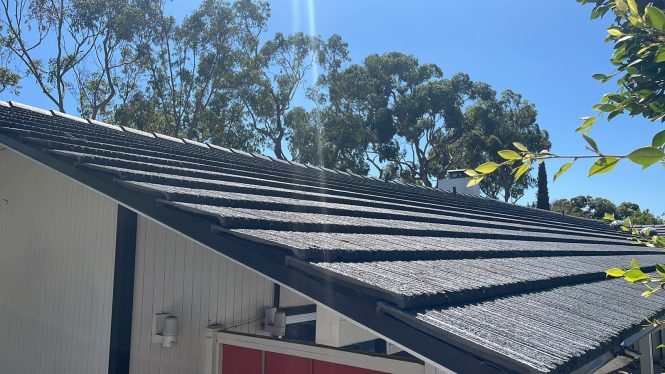

Dealing with roof moss growth is a crucial aspect of maintaining a healthy and well-maintained home. Roof moss, while often aesthetically unappealing, can lead to significant structural issues if left unchecked. This guide will walk you through the process of understanding the causes, identifying effective removal methods, and implementing preventative measures for a lasting solution. We’ll cover the underlying reasons behind moss growth, different removal techniques ranging from DIY approaches to professional solutions, and actionable steps to prevent future outbreaks. Furthermore, we will explore long-term strategies to protect your roof from moss growth. The structure of this guide is as follows: first, we’ll identify the causes of roof moss growth. Second, we will discuss different removal methods. Third, we’ll examine preventive strategies to halt future growth. Fourth, we’ll conclude with a summary of key takeaways and next steps. Finally, we will answer frequently asked questions to complete your understanding.
Understanding the Causes of Roof Moss Growth
Identifying the Root Causes
Roof moss growth is rarely a spontaneous event. It typically arises from a combination of environmental factors and specific roof conditions. Understanding these factors is crucial for effective removal and prevention. Moisture is a primary driver. Areas of the roof that retain water or experience prolonged dampness are more susceptible to moss colonization. This could include improperly sealed areas, inadequate drainage, or areas that consistently collect rainwater.
Identifying Factors Contributing to Growth
Furthermore, the type of roofing material itself can impact moss growth. Certain materials may retain moisture more easily than others. Shingles, tiles, and even flat roofs with improper drainage are potential breeding grounds for moss. Additionally, the presence of shaded or protected areas can contribute to dampness. Over time, this consistent dampness creates the ideal conditions for moss spores to thrive and proliferate, resulting in noticeable moss growth.
Addressing Underlying Issues
In severe cases, existing issues such as faulty flashing, improper ventilation, or missing shingles need to be addressed to prevent a recurrence of the problem. A thorough inspection by a professional roofer is recommended to identify any concealed issues contributing to the growth of moss. Addressing these issues from the start is essential for effectively dealing with the problem, as moss can often return if its underlying causes aren’t adequately addressed.
Effective Removal Methods for Roof Moss
DIY Removal Techniques
For smaller areas of moss growth, DIY removal methods can be a cost-effective option. A pressure washer, along with a gentle, non-abrasive cleaning solution, can often be sufficient for removing surface moss. Cleaning the roof with a mixture of water and dish soap can sometimes remove the moss without causing further damage. However, these techniques may not be suitable for extensive growth or persistent issues.
Professional Roof Cleaning Services
When moss growth is extensive or if you’re unsure about the safety of DIY methods, consider professional roof cleaning services. Professional cleaners utilize specialized equipment and cleaning solutions to remove moss effectively without damaging the roof’s structure. A professional assessment can also identify potential structural issues that might need attention. This approach ensures a thorough cleaning and may be necessary for a complete solution. Moreover, they will often have greater experience in dealing with diverse types of moss and roofing materials, allowing for a more accurate and effective process.
Considerations for Selection
Always ensure the cleaning team is qualified and experienced. Seek recommendations or research reviews to ensure that the chosen service aligns with your standards and specific needs.
Preventative Measures to Halt Future Growth
Enhancing Drainage Systems
Improving roof drainage systems is crucial in preventing the recurrence of moss growth. Ensuring proper downspouts, gutters, and roof surfaces are not allowing water to pool, reducing the chances of future moss issues. This preventative measure includes installing new gutters or downspouts, checking existing gutters for proper direction, and clearing obstructions to prevent water buildup.
Addressing Structural Issues
Repairing any damage to the roof’s structure—such as missing or damaged shingles, faulty flashing, or inadequate ventilation—is essential for preventing future moss growth. Moss thrives in areas with inadequate water drainage. Therefore, it is important to address these underlying issues to prevent further moss growth. By proactively repairing these areas, you can prevent the formation of an ideal environment for moss to take root.
Regular Maintenance Checkups
Regular roof maintenance is a proactive strategy for preventing moss growth. A bi-annual or annual inspection by a qualified roofing professional can help identify potential issues early. Identifying and fixing small problems before they escalate can prevent costly repairs later on. This approach ensures that the roof remains in good condition, reducing the likelihood of moss growth.
Case Study: A Homeowner’s Experience with Roof Moss
A homeowner reported significant moss growth on their asphalt shingle roof after several years without proper maintenance. Regular inspections and repairs, coupled with effective drainage solutions, significantly reduced the moss growth in subsequent years.
Additional Notes
This experience highlights the importance of regular inspections and preventative measures to stop roof moss growth before it becomes a major problem. Prevention is significantly more cost-effective than dealing with extensive moss growth later.
Conclusion
In conclusion, effectively dealing with roof moss growth requires a proactive and multifaceted approach. Understanding the root causes, employing appropriate removal methods, and focusing on preventative measures are key to a healthy roof and a well-maintained home. Schedule a professional inspection if you are unsure about the best course of action, as this proactive step can prevent further damage and potential costly repairs in the future. Contact a roofing specialist today for a free quote!